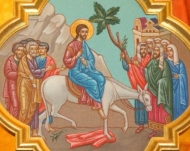 |
In the Eastern Catholic Church, Palm Sunday is often called the Entry of the Lord into Jerusalem. It is one of the Twelve Great Feasts of the liturgical year, and is the beginning of Holy Week. The day before Palm Sunday is known as Lazarus Saturday, and commemorates the resurrection of Lazarus from the dead.
Unlike in the Western Church, Palm Sunday is not considered to be a part of Lent and the Eastern Catholic Great Fast ends on the Friday before. So, Lazarus Saturday, Palm Sunday and Holy Week are considered to be a separate fasting period.
On Lazarus Saturday, the faithful in some churches prepare palm fronds by knotting them into crosses in preparation for the procession on Sunday. There is no canonical requirement as to what type of brnches must be used. In the Ukrainian Catholic Church the custom developed of using pussy willow instead of palm fronds because the latter cannot be grown in the climate of Ukraine.
Whatever the kind, these branches are blessed and distributed together with candles either during the All-Night Vigil on the Eve of the Feast (Saturday night), or before the Divine Liturgy on Sunday morning.
In parts of the Ukraine, now, the practice is for each family to bring its own bunch of pussy willows to church. For those families who have no access to pussy willow branches, there are bouquets of willows available at the entrance to the church.
The hangings and vestments in the church are changed to a festive color—in the Slavic tradition this is usually green.
The Troparion of the Feast indicates that the resurrection of Lazarus is a prefiguration of Jesus' own resurrection. The Great Entrance of the Divine Liturgy commemorates the "Entry of the Lord into Jerusalem," and so the meaningfulness of this moment is punctuated on Palm Sunday in some churches as everyone stands holding their branches and lit candles throughout the Liturgy. The faithful take these branches and candles home with them after the service, and keep them in their icon corner as a blessing.
